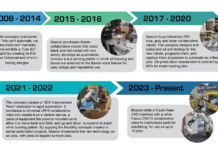by Andrew Reeder, Moulds Plus International
A company going green is not only socially responsible but also, financially responsible. The best way for plastic processing companies to go green is by reducing waste. The two most common forms of waste are scrap resin and wasted energy. Hence, using an effective purging compound will reduce both scrap resin and energy waste.
Purging
Purging a plastic processing machine can be financially and environmentally expensive. Using resin to purge a machine requires a large amount of energy due to the extended period of time it takes to clean the machine. Purging a machine with resin also produces a substantial amount of scrap because a large amount of resin is required to pass through the machine in order to clean it. Therefore, in order to reduce waste and make purging more efficient, companies should use a commercial purging compound. It is true that a purging compound costs more per pound when compared to natural resin. However, in comparison to the higher price per pound for a commercial purging compound, using resin to purge results in excessive amount of scrap produced, unnecessary energy consumed, and production time lost. All these factors result in a much larger monetary and environmental loss.
Recyclable Purging Compounds
It also is important to note that not all purging compounds are equal. Conventional purging compounds may reduce scrap and energy, however, very few are recyclable. The scrap produced by recyclable purging compounds may be either included with regrind and made into parts or sold to the plastic processors scrap dealer. Purging compounds that are not recyclable must be thrown out; this then ends up in a landfill and results in a less environmentally friendly method of purging. Throwing out purging scraps also lowers profits because funds are not recouped by selling them to the plastic processors scrap dealer or including them with regrind to make parts. Check with a purging compound supplier to see if recyclable grades are available.
Areas to Use a Purging Compound
There are three different areas in production where scrap and energy may be reduced when using a purging compound. Traditionally, the largest factor contributing to waste for processors is dark to light color changes. Using resin to purge a machine will require many press barrel capacities to remove the dark color, resulting in greater waste and more downtime. On the other hand, using an efficient purging compound will require only one press barrel capacity to clean the dark color from the machine.
Excessive waste also is common during material changes. Custom molders commonly need to address this issue because of the many different resins they work with on a daily basis. In many situations, the previous production resin will remain in the machine and be a source of contamination. In these situations, using resin to purge the machine will take much longer than a commercial purge compound. Therefore, companies that work with a wide range of resins should invest in a multi-purpose grade of purging compound that will be effective at purging a wide spectrum of resins.
The third common need for a purging agent is when carbon (which shows up as black specks) becomes a contamination issue. The best way to battle carbon problems is to use a purge compound in a preventative maintenance fashion. If the build-up of carbon becomes excessive, the only viable way to clean the screw is to pull it apart and clean it manually. Thus, using a purging compound in the beginning stages of carbonization will result in reduced scrap and energy and ultimately will increase production. Therefore, it is highly recommended to use a purge compound on shut-downs and start-ups in order to prevent carbon from forming on the screw.
Measuring the Benefits
It is understandable that businesses need to justify the investment involved with using a purging compound. Thus, data needs to be collected over a large span of time in order to quantitatively demonstrate the environmental and monetary savings from using a purging compound. Data should be collected on the present purging procedures (without commercial purge compound) and on the perspective commercial purging compound. The data collection should include downtime, scrap resin produced, and the amount of purging compound needed. Every plastic processing piece of equipment is unique in terms of power usage. Therefore, downtime will have to be interpolated into power usage for each piece of plastic processing equipment because of this variance.

Adjacent is a graph comparing the cost of using resin to purge a machine versus the cost of using a commercial purging compound. The trial was performed on a 300 ton injection molding machine (with hot runners) going from red HDPE to white HDPE. Using the Ultra Purge compound resulted in a 55 percent reduction in material costs and a 75 percent reduction in downtime (machine time = $300/hr). The total savings for this trial was $1,001.00. Please note: the energy consumption was not estimated because the hourly power usage for this particular injection molding press was unknown.
Conclusion
As the global population grows and technology advances, it becomes more important that companies take action in order to reduce their carbon footprint. A collective effort to decrease scrap resin and energy consumption by plastic processing companies will equate to a large global effort in conserving energy/resources and reducing pollution. Reducing a companys carbon footprint not only will be good for the environment but also, good for business.
Moulds Plus International is the manufacturer of Ultra Purge, a purging compound for thermoplastic injection molders, blow molders, and extrusion companies. Moulds Plus International has offices and distributors located around the world to assist customers on a global level. Moulds Plus International offers free samples of Ultra Purge and in-plant consultations. For more information, call (877) 884-3129 or visit www.ultrapurge.com.




